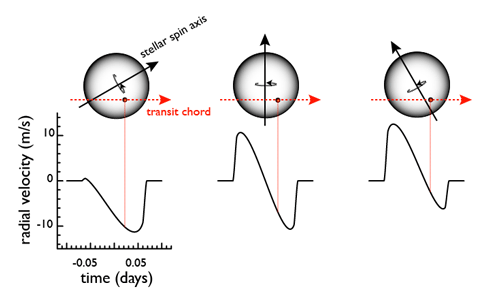first quarter numbers3
greg posted in exoplanet detection on April 2nd, 2008

Image Source.
Back in 2002, Keith Horne gave a talk at the Frontiers in Research on Extrasolar Planets meeting at the Carnegie Institute in Washington and showed an interesting table:

At that time, there were more than two dozen active searches for transiting extrasolar planets, but only a single transiting planet — HD 209458 b — had been detected. Transits were generating a lot of excitement, but paradoxically, the community was well into its third straight year with no transit detections. The photometric surveys seemed to be just on the verge of really opening the floodgates, with a total theoretical capacity to discover ~200 planets per month.
It’s been six years, and the total transiting planet count is nowhere near 14,000. Most of the surveys on the table have had a tougher-than-expected time with detections because of the large number of false positives, and because of the need to obtain high-precision radial velocities on large telescopes to confirm candidate transiting planets. Indeed, the surveys that were sensitive to dimmer stars have largely faded out. It’s just too expensive to get high-precision velocities for V>15 stars. With the exception of the OGLE survey (which had been set up to look for microlensing during the 1990s, and which had established a robust pipeline early on) none of the surveys that employed telescopes with apertures larger than 12 cm have been successful. The currently productive photometric projects: TrES, XO, HATnet, and SuperWASP all rely on telescopes of 10 to 11 cm aperture to monitor tens of thousands to hundreds of thousands of stars, and all are sensitive to planets transiting stars in the V~10 to V~12 magnitude range. This magnitude range is the sweet spot: there are plenty of stars (and hence plenty of transits) and the stars are bright enough for reasonably efficient radial velocity confirmation.
Yesterday, SuperWASP rolled out 10 new transits at once, dramatic evidence of the trend toward planetary commoditization and of the fact that it’s getting tougher to make a living out on the discovery side. The detection of new planets is growing routine enough that in order to generate a news splash, you need multiple planets, and the more the better. This inflationary situation for new transit news is highly reminiscent of where the Doppler surveys were at seven years ago. For example, on April 4, 2001, the Geneva team put out a press release announcing the discovery of eleven new planets (including current oklo fave HD 80606b).
I’d like to register some annoyance with this latest SuperWASP announcement. There are no coordinates for the new planets, making it impossible to confirm the transits. There is no refereed paper. The data on the website are inconsistent, making it hard to know what’s actually getting announced. I was astonished, for example, that WASP-6 is reported on the website to have a radius 50% that of Jupiter, and a mass of 1.3 Jovian masses:

That’s nuts! If the planet is so small, why is the transit so deep? And a 2200 K surface temperature for a 3.36d planet orbiting a G8 dwarf? Strange. Perhaps the radius and mass have been reversed? In addition, there are weird inconsistencies between the numbers quoted in the media diagram and in the tables. For example, the diagram pegs WASP-7 at 0.67 Jovian masses, whereas the table lists it at 0.86 Jovian masses. WASP-10 has a period of 5.44 days in the table and 3.093 days in the summary diagram. Putting out a press release without the support a refereed paper is never a very good idea, even when there’s a danger that another team will steal your thunder with an even larger batch of planets.
Despite the difficulty in getting accurate quotes from the exchange, it’s interesting to see how the ten new planets stack up in the transit pricing formula. Using the data from the new WASP diagram (except for the 0.66 day period listed for WASP-9) and retaining the assumption that USD 25M has been spent in aggregate on ground-based transit searches, the 46 reported transits come out with the following valuations:
| Planet | Value |
| CoRoT-Exo-1 b | $78,818 |
| CoRoT-Exo-2 b | $48,558 |
| Gliese 436 b | $3,970,811 |
| HAT-P-1 b | $883,671 |
| HAT-P-2 b | $77,938 |
| HAT-P-3 b | $260,473 |
| HAT-P-4 b | $172,851 |
| HAT-P-5 b | $133,239 |
| HAT-P-6 b | $224,110 |
| HAT-P-7 b | $54,382 |
| HD 149026 b | $722,590 |
| HD 17156 b | $869,254 |
| HD 189733 b | $2,429,452 |
| HD 209458 b | $10,103,530 |
| Lupus TR 3 b | $17,488 |
| OGLE TR 10 b | $60,260 |
| OGLE TR 111 b | $74,524 |
| OGLE TR 113 b | $36,599 |
| OGLE TR 132 b | $12,326 |
| OGLE TR 182 b | $15,261 |
| OGLE TR 211 b | $18,653 |
| OGLE TR 56 b | $19,761 |
| SWEEPS 04 | $1,826 |
| SWEEPS 11 | $193 |
| TrES-1 | $556,308 |
| TrES-2 | $113,043 |
| TrES-3 | $93,018 |
| TrES-4 | $205,508 |
| WASP-1 | $190,539 |
| WASP-2 | $188,956 |
| WASP-3 | $105,284 |
| WASP-4 | $104,581 |
| WASP-5 | $65,926 |
| WASP-6 | $339,387 |
| WASP-7 | $402,125 |
| WASP-8 | $209,169 |
| WASP-9 | $106,532 |
| WASP-10 | $74,281 |
| WASP-11 | $233,334 |
| WASP-12 | $160,189 |
| WASP-13 | $461,104 |
| WASP-14 | $14,450 |
| WASP-15 | $243,780 |
| XO-1 | $436,533 |
| XO-2 | $375,996 |
| XO-3 | $33,367 |
The ten new WASP planets (assuming that the correct parameters have been used) contribute about 1/10th of the total catalog value. There will likely be interesting follow-up opportunities on these worlds from ground and from space, but its unlikely that they’ll rewrite the book on our overall understanding of the field.
It’s interesting to plot the detection rate via transits in comparison to the overall detection rate of extrasolar planets. (The data for the next plot was obtained using the histogram generators at the Extrasolar Planets Encyclopaedia, which are very useful and are always up-to-date.)

It’s a reasonable guess that 2008 will be the first year in which the majority of discoveries arrive via the transit channel, especially if CoRoT comes through with a big crop. Radial velocity, however holds an edge in that it’s surveying the brightest stars, and (so far) has been responsible for progress toward the terrestrial-mass regime. I think that we might be seeing planets of only a few Earth masses coming out of the RV surveys during the coming year. Certainly, everything else being equal, a planet orbiting an 8th magnitude star is far more useful for follow-up characterization than a planet orbiting a 13th magnitude star.




























































































